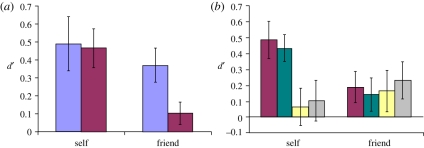Figure 2.
(a) Results from experiment 1. Whereas discrimination of friends' motion showed a marked inversion effect, participants' ability to discriminate self-produced motion was insensitive to inversion. (b) Results from experiment 2. When presented with inverted avatar stimuli, participants could correctly discriminate their own veridical motion (i.e. without any disruption) and sequences of anti-frames. However, when the temporal or rhythmic properties were disrupted either through uniform slowing, or random acceleration/deceleration, self-discrimination did not exceed chance levels. Error bars denote standard error of the mean in both figures. (a) Purple bars, upright; maroon bars, inverted. (b) Maroon bars, inverted veridical; green bars, anti-sequence; yellow bars, rhythm disrupted; grey bars, slowed.

